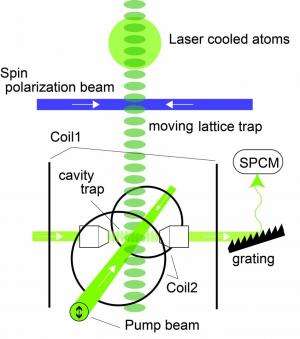Quantum computing: Manipulating a single nuclear spin qubit of a laser cooled atom

It is advantageous to implement a quantum bit (qubit) with a single nuclear spin because the nuclear spin is robust against any stray magnetic fields. This robustness can be attributed to the small magnitude of the magnetic moment of the nuclear spin compared with that of the electronic spin.
However, the long coherence time of the nuclear spin qubit is normally traded off for enabling fast and highly efficient state measurements.
Now, Atsushi Noguchi, Yujiro Eto, Masahito Ueda and Mikio Kozuma at Tokyo Institute of Technology and Tokyo University have shown that a quantum state can be measured with high speed and high efficiency using a cavity quantum electrodynamics (QED) system with a single ytterbium (Yb) atom.
The researchers loaded a single laser cooled Yb atom into a high-finesse optical cavity with a moving lattice, and its nuclear spin state was manipulated using a nuclear magnetic resonance technique (NMR) (see figure 1).
A highly reliable quantum state control with fidelity and purity greater than 0.98 and 0.96, respectively, was confirmed by full quantum state tomography— enabling a high speed (500 ?s) and high efficiency (0.98) projective measurement . Notably, long coherence times (T1 = 0.49 s and T2 = 0.10 s) were maintained.
These values are sufficiently large to implement scalable quantum computation via the application of our technique to create a many-body entangled state in an optical lattice.
More information: Noguchi, A. et al. Quantum-state tomography of a single nuclear spin qubit of an optically manipulated ytterbium atom, Physical Review A 84, 030301(R) (2011). DOI: 10.1103/PhysRevA.84.030301
Journal information: Physical Review A
Provided by Tokyo Institute of Technology


















